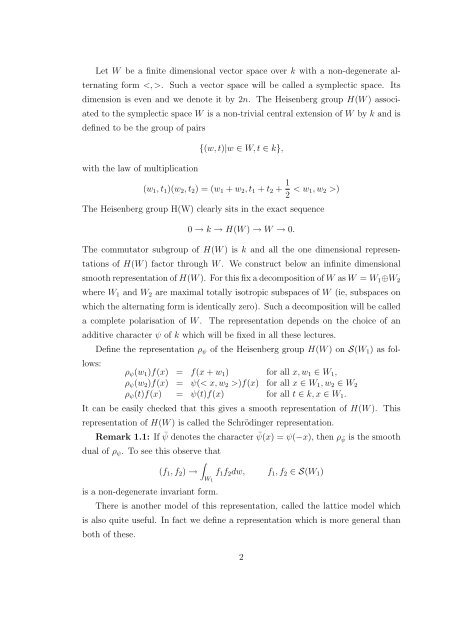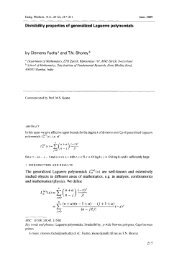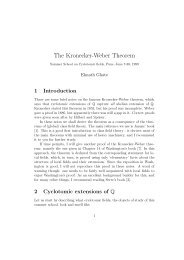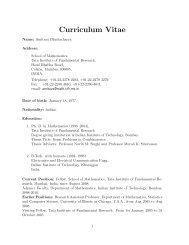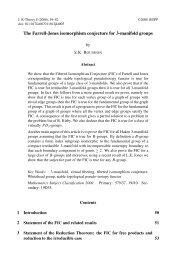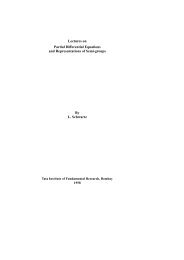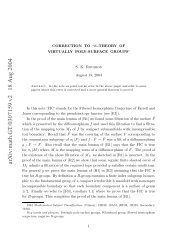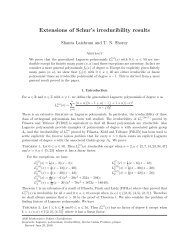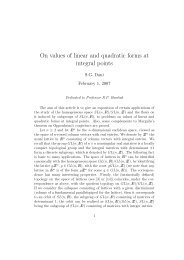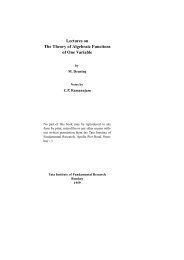Weil Representation, Howe Duality, and the Theta correspondence
Weil Representation, Howe Duality, and the Theta correspondence
Weil Representation, Howe Duality, and the Theta correspondence
Create successful ePaper yourself
Turn your PDF publications into a flip-book with our unique Google optimized e-Paper software.
Let W be a finite dimensional vector space over k with a non-degenerate alternatingform . Such a vector space will be called a symplectic space. Itsdimension is even <strong>and</strong> we denote it by 2n. The Heisenberg group H(W ) associatedto <strong>the</strong> symplectic space W is a non-trivial central extension of W by k <strong>and</strong> isdefined to be <strong>the</strong> group of pairswith <strong>the</strong> law of multiplication{(w, t)|w ∈ W, t ∈ k},(w 1 , t 1 )(w 2 , t 2 ) = (w 1 + w 2 , t 1 + t 2 + 1 2 < w 1, w 2 >)The Heisenberg group H(W) clearly sits in <strong>the</strong> exact sequence0 → k → H(W ) → W → 0.The commutator subgroup of H(W ) is k <strong>and</strong> all <strong>the</strong> one dimensional representationsof H(W ) factor through W . We construct below an infinite dimensionalsmooth representation of H(W ). For this fix a decomposition of W as W = W 1 ⊕W 2where W 1 <strong>and</strong> W 2 are maximal totally isotropic subspaces of W (ie, subspaces onwhich <strong>the</strong> alternating form is identically zero). Such a decomposition will be calleda complete polarisation of W .The representation depends on <strong>the</strong> choice of anadditive character ψ of k which will be fixed in all <strong>the</strong>se lectures.Define <strong>the</strong> representation ρ ψ of <strong>the</strong> Heisenberg group H(W ) on S(W 1 ) as follows:ρ ψ (w 1 )f(x) = f(x + w 1 ) for all x, w 1 ∈ W 1 ,ρ ψ (w 2 )f(x) = ψ(< x, w 2 >)f(x) for all x ∈ W 1 , w 2 ∈ W 2ρ ψ (t)f(x) = ψ(t)f(x) for all t ∈ k, x ∈ W 1 .It can be easily checked that this gives a smooth representation of H(W ). Thisrepresentation of H(W ) is called <strong>the</strong> Schrödinger representation.Remark 1.1: If ¯ψ denotes <strong>the</strong> character ¯ψ(x) = ψ(−x), <strong>the</strong>n ρ ¯ψ is <strong>the</strong> smoothdual of ρ ψ . To see this observe that∫(f 1 , f 2 ) → f 1 f 2 dw, f 1 , f 2 ∈ S(W 1 )W 1is a non-degenerate invariant form.There is ano<strong>the</strong>r model of this representation, called <strong>the</strong> lattice model whichis also quite useful. In fact we define a representation which is more general thanboth of <strong>the</strong>se.2


